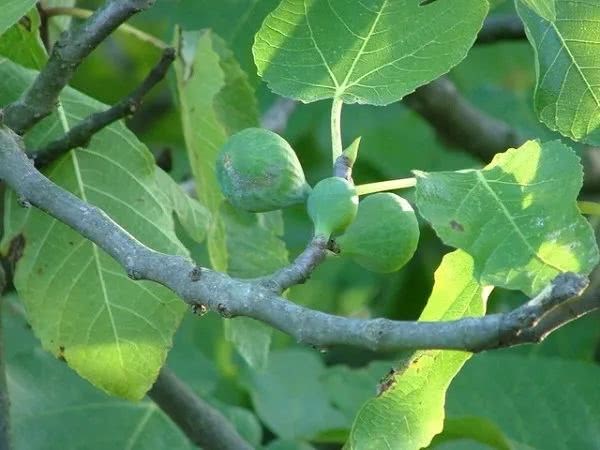The love and killing in nature is about figs and fig wasps.

Speaking of Ficus plants, northerners may think of fig trees with slender branches and strangely shaped leaves, while southerners may think of giant banyan trees with thick shady ground and fluttering air roots. Regardless of size, their "fruits" have a highly consistent and unique shape.
The delicious fruit is hidden inside
The inflorescence of the genus banyan is called cryptocephalus, which grows into a round "jar" shape and wraps the real flowers inside. We can't see flowers, so we have the name fig. The real fruit of the genus banyan is very small, belongs to achenes and is hidden in hypertrophic hidden heads.
The most famous banyan fruit is figs, and the hidden heads of other banyan trees can also be eaten. When I was studying in Hong Kong, I once saw a lot of birds eating the "fruit" of the banyan tree (to be exact, it should be the hidden head inflorescence), probably the Ficus microcarpa. I also tried to eat, in fact, it is not delicious, the inflorescence is very small, there are a lot of withered flowers, taste like eating grass.
Secret fear warning ahead!
The section of a fig fruit showing its inner achene. Picture: Kyle_the_hacker / wikipedia
The fruit of the big fruit banyan (Ficus auriculata) is said to grow to ten centimeters in diameter, alias pomegranate, honey loquat and Bordeaux. Ah, it sounds delicious.
The fruit of a big banyan. Picture: Koppchen / wikipedia
Also worth mentioning with foodie is Ficus pumila, whose hidden inflorescence is not delicious, but achenes are rich in pectin, which can be made into jelly-like snacks. Aiyu Jelly (Vegetarian Gelatin) in Taiwan dessert is made from a variety of Ficus pumila (Ficus pumilavar.awkeotsang).
The hidden head inflorescence and inner achene of Ficus pumila. Photo: Zheng Yuqing / anntw.com
You die for me, I live for you.
On the surface, the relationship between plants and pollinating insects is intimate, but there is actually hidden competition. Banyan trees (such as figs, Ficus pumila) and banyan wasps have reached an extreme degree in this respect.
In the family Chalcidoid, there are several families, such as Agaonidae, which are called banyan wasps because of their special relationship with banyan plants.
Banyan plants are highly dependent on banyan wasps for pollination. The cryptocephalic inflorescences of the genus Ficus can be divided into two species, one containing seed-producing female flowers, and the other containing male flowers and sterile female flowers, called gall [yellowish ng] flowers. Gall flowers also have ovaries, but not for fruit, but to provide an environment for fig wasp larvae to grow. The larvae of banyan wasps feed on nutrients in the ovary and grow and mature in gall flowers. Females and drones generally mate in the fruit. At this time, the male flowers also mature, and the pollen is sprinkled on the female bees.
The winged female bee climbs out of her home, flies outside in search of other hidden inflorescences, and gets in through the small window at the top. If it drills into an inflorescence with gall flowers, it lays eggs on the gall flowers, and the generation of banyan wasps can continue.
A small wasp named Ceratosolen capensis crawled out of the gall flower. Picture: figweb
If there is only a female flower with fruiting potential in the inflorescence, and the female bee has no place to lay eggs, it can only be trapped in it. The fig window is blocked by layers of tissue, making it difficult to climb out again. It is the fig wasp that sacrifices its life to keep the figs alive. The pollen of the female bees falls on these female flowers, so the female flowers bear fruit, and then the cryptocephalic inflorescence expands, attracting animals to feed and spread the seeds.
The banyan wasp drilled into the hidden head inflorescence. Picture: naturalezacuriosa.com
By the way, many of the figs grown commercially are parthenocarpy and do not need pollination, and the hidden inflorescence will also expand, so the figs you eat may not necessarily have the contribution of fig wasps.
There are also some unpollinated banyan wasps that drill directly through the "walls" of hidden inflorescences from the outside and lay eggs inside. After hatching, either eat the ovary of gall flowers, or eat the larvae of other banyan wasps.
Unpollinated Apocrypta guineensis uses an ovipositor to pierce the "wall" to lay eggs. Picture: JMK / wikipedia
The survival of the banyan wasp depends on the sacrifice of the female flowers of the banyan tree, and the reproduction of the banyan tree must be based on the life of the female banyan wasp. Both must depend on the other to survive, but the life of both means the death of the other. This kind of relationship is hardly friendship or cooperation, perhaps it can be said to be the collocation of sickness and sickness.
This article is authorized to be reproduced from the author of the species calendar @ Red Queen.
If you like her, you can still follow her.
The squirrel nest of wrasse shrimp
Id: gh_6422b69589c2
Strange species and interesting knowledge
Calendar Niang today's avatar
Sangke jackfruit
- Prev

The Elephant War: from the Age of Cold weapons to the 21st Century
In our impression, elephants seem to represent kindness and honesty, especially the smaller Asian elephant (Elephas maximus), which is famous for its high IQ and meekness. But history has played a joke on us: it has always been.
- Next

Meet with the fruit shell store in Beijing 798 this Saturday
August 11 (Saturday) 11:00-21:00 Beijing 798 machine encounter space fruit shell shop will be invited to participate in the third China's most beautiful book store week closing market-- unread summer Reading Park...
Related
- Wuhan Hospital Iron Tree Blooming Result Was Instantly Frightened by the Gardener Master
- Which variety of camellia is the most fragrant and best? Which one do you like best?
- What is the small blue coat, the breeding methods and matters needing attention of the succulent plant
- Dormancy time and maintenance management of succulent plants during dormancy
- Minas succulent how to raise, Minas succulent plant pictures
- What are the varieties of winter succulent plants
- How to raise succulent plants in twelve rolls? let's take a look at some experience of breeding twelve rolls.
- Attention should be paid to water control for succulent plants during dormant period (winter and summer)
- Watering experience of twelve rolls of succulent plants
- Techniques for fertilizing succulent plants. An article will let you know how to fertilize succulent plants.

